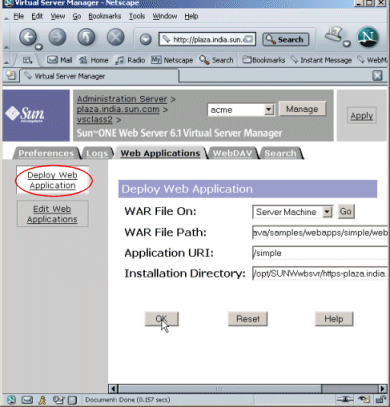Deploying Your First Web Application: A Step-by-Step Guide

Deploying your first web application can be an exciting and daunting task, but with the right guidance, you can do it successfully. This step-by-step guide will provide you with the essential steps to deploy your web application efficiently.

Prerequisites:

- A developed web application
- A web hosting provider
- A domain name (optional)
Step 1: Choose a Web Hosting Provider
The first step is to select a web hosting provider that meets your application’s requirements. Consider factors such as storage space, bandwidth, security features, and customer support.
Step 2: Create an Account and Set Up Hosting
Once you’ve chosen a hosting provider, create an account and choose the hosting plan that suits your needs. Follow the instructions provided by the provider to set up your hosting environment.
Step 3: Configure Your Web Application
Configure your web application to run on your hosting environment. This may involve setting up databases, modifying configuration files, or adapting your code to work with the hosting provider’s platform.
Step 4: Upload Your Application Files
Upload your web application files via FTP or another file transfer method to the designated directory on your hosting server. Ensure you have permissions to access and write to the directory.
Step 5: Set Up a Domain Name (Optional)
If you have purchased a domain name, you need to configure your hosting account to point to it. This involves mapping the domain to your web hosting server’s IP address.
Step 6: Test and Debug
Thoroughly test your application to ensure it functions correctly on the live server. Check for any errors or inconsistencies and make the necessary adjustments to your code or configuration.
Step 7: Monitor and Maintain
Once your application is deployed, it’s crucial to monitor its performance and maintain it regularly. This includes checking for security vulnerabilities, updating software, and making backups to protect against data loss.
Additional Tips:
- Start with a small-scale deployment to minimize risk.
- Use version control to track changes and facilitate rollbacks if necessary.
- Consider using a content delivery network (CDN) to improve performance.
- Stay up-to-date with best practices for web application deployment and security.Deploying Your First Web Application: A Step-by-step Guide
Executive Summary
Deploying your first web application can be a daunting task, but it doesn’t have to be. By following these steps, you can ensure a successful deployment and get your web application up and running in no time!
Introduction
In today’s digital world, having a website is essential for any business or individual wanting to establish an online presence. With the proliferation of user-friendly website builders and affordable web hosting services, it’s fairly straightforward to create and distribute your website. But if you’re planning on developing a complex web application, the deployment process might be a bit more involved.
Planning and Preparation
Before you start deploying your web application, it’s important to have a plan in place. This will help you avoid any surprises or setbacks during the process. Here are a few things to consider:
- Choose a deployment strategy. There are two main deployment strategies: blue-green deployment and canary deployment. Blue-green deployment is a safer option, as it involves creating a new version of your application and then gradually switching over traffic from the old version to the new version. Canary deployment is a riskier option, but it can be more efficient, as it involves deploying a new version of your application alongside the old version and then gradually increasing the traffic to the new version.
- Set up a deployment pipeline. A deployment pipeline is a set of automated tasks that are executed each time you deploy your web application. This helps to ensure that your deployments are consistent and error-free.
- Test your deployment. Once you have a deployment plan in place, it’s important to test it out to make sure that it works as expected. This will help you identify any potential problems before you deploy your web application to production.
Choosing a Web Hosting Provider
One of the most important decisions you’ll make when deploying your web application is choosing a web hosting provider. There are many different web hosting providers out there, so it’s important to do your research and choose one that is right for your needs. Here are a few things to consider when choosing a web hosting provider:
- Uptime. The uptime of a web hosting provider is the percentage of time that their servers are up and running. You want to choose a web hosting provider with a high uptime, so that your website is always available to visitors.
- Bandwidth. The bandwidth of a web hosting provider is the amount of data that can be transferred to and from their servers each month. You want to choose a web hosting provider with enough bandwidth to handle the traffic to your website.
- Storage. The storage space of a web hosting provider is the amount of space that you have to store your website’s files. You want to choose a web hosting provider with enough storage space to accommodate your website’s files.
- Support. The support of a web hosting provider is the quality of the customer service that they provide. You want to choose a web hosting provider with good support, so that you can get help if you need it.
Setting Up Your Web Application
Once you have chosen a web hosting provider, you need to set up your web application. This involves uploading your website’s files to the web hosting provider’s servers and configuring your web application’s settings. Here are a few things to consider when setting up your web application:
- Choose a domain name. Your domain name is the address of your website on the internet. You want to choose a domain name that is easy to remember and relevant to your website’s content.
- Set up a database. If your web application requires a database, you need to set up a database on your web hosting provider’s servers.
- Configure your web application’s settings. Once you have uploaded your website’s files and set up your database, you need to configure your web application’s settings. This includes setting up your web application’s security settings, performance settings, and other settings.
Testing and Debugging Your Web Application
Once you have set up your web application, you need to test it to make sure that it works as expected. Here are a few things to consider when testing your web application:
- Test your website’s functionality. Make sure that all of your website’s features are working as expected.
- Test your website’s performance. Make sure that your website loads quickly and responds to user input quickly.
- Test your website’s security. Make sure that your website is secure from hackers and other threats.
Monitoring Your Web Application
Once you have deployed your web application, you need to monitor it to make sure that it is running smoothly. Here are a few things to consider when monitoring your web application:
- Monitor your website’s uptime. Make sure that your website is always available to visitors.
- Monitor your website’s traffic. Track the number of visitors to your website and the pages that they visit.
- Monitor your website’s performance. Make sure that your website loads quickly and responds to user input quickly.
Conclusion
Deploying your first web application can be a daunting task, but it doesn’t have to be. By following these steps, you can ensure a successful deployment and get your web application up and running in no time!
Keyword Phrase Tags
- web application deployment
- web hosting provider
- setting up a web application
- testing a web application
- monitoring a web application


I avoided the {big} headache in deploying my app to production by following this guide step-by-step! Thanks to the author for this valuable resource.
This guide is totally garbage. It left out so many important details and I’m still struggling to get my app up and running.
In addition to the guide, I found the following resources helpful: [link 1], [link 2]. They provide additional tips and tricks for deploying web applications.
I disagree with the author’s recommendation to use Heroku. I’ve had much better experiences with AWS and would argue that it’s a superior platform for deploying web applications.
Oh, the irony! I’m trying to deploy my first web application, and I come across a guide that’s so poorly written, I can’t even understand it.
Wow, thanks for this amazing guide! I’m sure it will be super helpful to all the experts out there who already know how to deploy web applications.
I’m not sure what’s more confusing, the guide or the comments. This is like trying to assemble IKEA furniture in the dark!
I’m not convinced that this guide will actually work. I’ve tried following it multiple times, and I still can’t get my app to deploy.
I’m curious about the author’s experience with deploying web applications. How many apps have they actually deployed? I’m wondering if they’re qualified to write a guide on the subject.
I’m so excited to try out this guide! I’ve been wanting to deploy my first web application for ages, and I think this is just what I needed to get started.